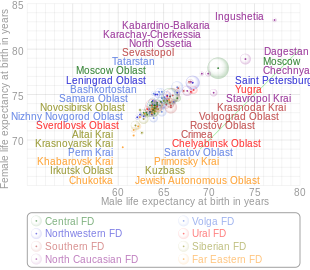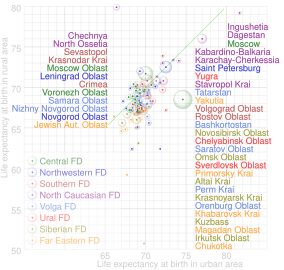Chechnya
Chechen Republic | |
|---|---|
| Чеченская Республика | |
| Other transcription(s) | |
| • Chechen | Нохчийн Республика |
|
2021 Census)[7] | |
| • Total | 1,510,824 |
| ISO 3166 code | RU-CE |
| License plates | 95 |
| OKTMO ID | 96000000 |
| Official languages | Russian;[9] Chechen[10] |
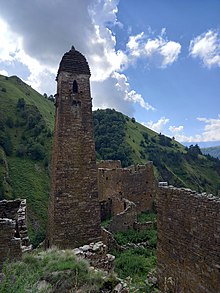
Chechnya,

After the

The republic covers an area of 17,300 square kilometres (6,700 square miles), with a population of over 1.5 million residents as of 2021[update].[7] It is home to the indigenous
and largest city.History
| History of Chechnya | ||||||
|---|---|---|---|---|---|---|
 | ||||||
| Prehistory | ||||||
|
||||||
| Ancient | ||||||
| Medieval | ||||||
| Early modern | ||||||
| Modern | ||||||
|
||||||
Origin of Chechnya's population
According to Leonti Mroveli, the 11th-century Georgian chronicler, the word Caucasian is derived from the Nakh ancestor Kavkas.[14] According to George Anchabadze of Ilia State University:
The Vainakhs are the ancient natives of the Caucasus. It is noteworthy, that according to the genealogical table drawn up by Leonti Mroveli, the legendary forefather of the Vainakhs was "Kavkas", hence the name Kavkasians, one of the ethnicons met in the ancient Georgian written sources, signifying the ancestors of the Chechens and Ingush. As appears from the above, the Vainakhs, at least by name, are presented as the most "Caucasian" people of all the Caucasians (Caucasus – Kavkas – Kavkasians) in the Georgian historical tradition.[15][16]
American linguist
Prehistory
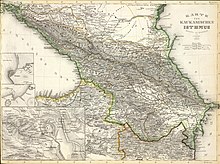
Traces of human settlement dating back to 40,000 BC were found near
The
Pre-imperial era
The German scientist
According to the missionary Pian de Carpine, a part of the Alans had successfully resisted a Mongol siege on a mountain for 12 years:[21][full citation needed]
When they (the Mongols) begin to besiege a fortress, they besiege it for many years, as it happens today with one mountain in the land of the Alans. We believe they have been besieging it for twelve years and they (the Alans) put up courageous resistance and killed many Tatars, including many noble ones.
— Giovanni da Pian del Carpine, report from 1250
This twelve year old siege is not found in any other report, however the Russian historian A. I. Krasnov connected this battle with two Chechen folktales he recorded in 1967 that spoke of an old hunter named Idig who with his companions defended the Dakuoh mountain for 12 years against Tatar-Mongols. He also reported to have found several arrowheads and spears from the 13th century near the very mountain at which the battle took place:[22]
The next year, with the onset of summer, the enemy hordes came again to destroy the highlanders. But even this year they failed to capture the mountain, on which the brave Chechens settled down. The battle lasted twelve years. The main wealth of the Chechens – livestock – was stolen by the enemies. Tired of the long years of hard struggle, the Chechens, believing the assurances of mercy by the enemy, descended from the mountain, but the Mongol-Tatars treacherously killed the majority, and the rest were taken into slavery. This fate was escaped only by Idig and a few of his companions who did not trust the nomads and remained on the mountain. They managed to escape and leave Mount Dakuoh after 12 years of siege.
— Amin Tesaev, "The Legend and Struggle of the Chechen Hero Idig (1238–1250)"
In the 14th and 15th centuries, there was frequent warfare between the Chechens,
The 16th century saw the first Russian involvement in the Caucasus. In 1558, Temryuk of Kabarda sent his emissaries to Moscow requesting help from
Imperial rule
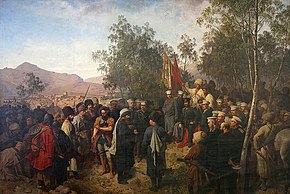
As the Russians took control of the Caspian corridor and moved into Persian-ruled
Under intermittent Persian rule since 1555, in 1783 the eastern Georgians of
Following the forced ceding of the current territories of Dagestan, most of Azerbaijan, and Georgia by Persia to Russia, following the Russo-Persian War of 1804–1813 and its resultant Treaty of Gulistan, Russia significantly widened its foothold in the Caucasus at the expense of Persia.[31] Another successful Caucasus war against Persia several years later, starting in 1826 and ending in 1828 with the Treaty of Turkmenchay, and a successful war against Ottoman Turkey in 1828 and 1829, enabled Russia to use a much larger portion of its army in subduing the natives of the North Caucasus.

The resistance of the Nakh tribes never ended and was a fertile ground for a new Muslim-
The tsarists' regime used a different approach at the end of the 1860s. They offered Chechens and Ingush to leave the Caucasus for the Ottoman Empire (see
On 21 December 1917,
Soviet rule
During Soviet rule, Chechnya and Ingushetia were combined to form the
Troops assembled villagers and townspeople, loaded them onto trucks – many deportees remembered that they were Studebakers, fresh from Lend-Lease deliveries over the Iranian border – and delivered them at previously designated railheads. ... Those who could not be moved were shot. ... [A] few fighters aside, the entire Chechen and Ingush nations, 496,460 people, were deported from their homeland.[39]
The deportation was justified by the materials prepared by NKVD officer Bogdan Kobulov accusing Chechens and Ingush in a mass conspiracy preparing rebellion and providing assistance to the German forces. Many of the materials were later proven to be fabricated.[40] Even distinguished Red Army officers who fought bravely against Germans (e.g. the commander of 255th Separate Chechen-Ingush regiment Movlid Visaitov, the first to contact American forces at Elbe river) were deported.[41] There is a theory that the real reason why Chechens and Ingush were deported was the desire of Russia to attack Turkey, an anti-communist country, as Chechens and Ingush could impede such plans.[29] In 2004, the European Parliament recognized the deportation of Chechens and Ingush as an act of genocide.[42]
The territory of the Chechen-Ingush Autonomous Soviet Socialist Republic was divided between
The Chechens and Ingush were allowed to return to their land after 1956 during
The Russification policies towards Chechens continued after 1956, with Russian language proficiency required in many aspects of life to provide Chechens better opportunities for advancement in the Soviet system.[29]
On 26 November 1990, the Supreme Council of Chechen-Ingush ASSR adopted the "Declaration of State Sovereignty of the Chechen-Ingush Republic". This declaration was part of the reorganisation of the Soviet Union. This new treaty was to be signed 22 August 1991, which would have transformed 15 republic states into more than 80. The 19–21 August
With the impending dissolution of the Soviet Union in 1991, an independence movement, the
During the Chechen Revolution, the Soviet Chechen leader Doku Zavgayev was overthrown and Dzhokhar Dudayev seized power. On 1 November 1991, Dudaev's Chechnya issued a unilateral declaration of independence. In the ensuing decade, the territory was locked in an ongoing struggle between various factions, usually fighting unconventionally.
Chechen Wars and brief independence

The First Chechen War took place from 1994 to 1996, when Russian forces attempted to regain control over Chechnya. Despite overwhelming numerical superiority in men, weaponry, and

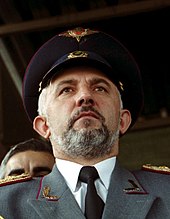
In April 1996, the first democratically elected president of Chechnya, Dzhokhar Dudayev, was killed by Russian forces using a booby trap bomb and a missile fired from a warplane after he was located by triangulating the position of a satellite phone he was using.[44]
The widespread
After the war, parliamentary and presidential elections took place in January 1997 in Chechnya and brought to power new President Aslan Maskhadov, chief of staff and prime minister in the Chechen coalition government, for a five-year term. Maskhadov sought to maintain Chechen sovereignty while pressing the Russian government to help rebuild the republic, whose formal economy and infrastructure were virtually destroyed.
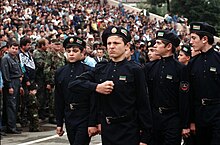
In light of the devastated economic structure, kidnapping emerged as the principal source of income countrywide, procuring over US$200 million during the three-year independence of the chaotic fledgling state,[48] although victims were rarely killed.[49] In 1998, 176 people were kidnapped, 90 of whom were released, according to official accounts. President Maskhadov started a major campaign against hostage-takers, and on 25 October 1998, Shadid Bargishev, Chechnya's top anti-kidnapping official, was killed in a remote-controlled car bombing. Bargishev's colleagues then insisted they would not be intimidated by the attack and would go ahead with their offensive. Political violence and religious extremism, blamed on "Wahhabism", was rife. In 1998, Grozny authorities declared a state of emergency. Tensions led to open clashes between the Chechen National Guard and Islamist militants, such as the July 1998 confrontation in Gudermes.

The
Post-war reconstruction and insurgency
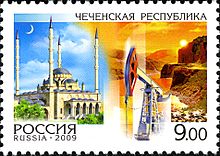
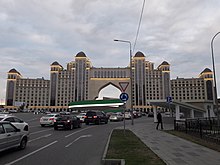
Chechen rebels continued to fight Russian troops and conduct terrorist attacks.[53][page needed] In October 2002, 40–50 Chechen rebels seized a Moscow theater and took about 900 civilians hostage.[37] The crisis ended with 117 hostages and up to 50 rebels dead, mostly due to an unknown aerosol pumped into the building by Russian special forces to incapacitate the people inside.[54][55][56]
In response to the increasing terrorism, Russia tightened its grip on Chechnya and expanded its anti-terrorist operations throughout the region. Russia installed a pro-Russian Chechen regime. In 2003, a referendum was held on a constitution that reintegrated Chechnya within Russia but provided limited autonomy. According to the Chechen government, the referendum passed with 95.5% of the votes and almost 80% turnout.
In September 2004, separatist rebels
Since 2007, Chechnya has been governed by Ramzan Kadyrov. Kadyrov's rule has been characterized by high-level corruption, a poor human rights record, widespread use of torture, and a growing cult of personality.[62][63] Allegations of anti-gay purges in Chechnya were initially reported on 1 April 2017.
In April 2009, Russia ended its counter-terrorism operation and pulled out the bulk of its army.
The Chechen government has been outspoken in its support for the 2022
Geography
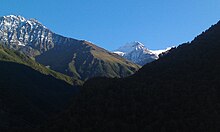
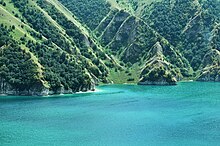
Situated in the eastern part of the
- Area: 17,300 km2 (6680 sq mi)
- Borders:
- Internal:
- Dagestan (NE)
- Ingushetia (W)
- North Ossetia–Alania (W)
- Stavropol Krai (NW)
- Foreign:
- Georgia (Kakheti and Mtskheta-Mtianeti) (S)
- Internal:
Rivers:
- Terek
- Sunzha
- Argun
Climate
Despite a relatively small territory, Chechnya is characterized by a variety of climate conditions. The average temperature in Grozny is 11.2 °C (52.1 °F).[69]
Cities and towns with over 20,000 people

- Grozny (capital)
- Shali
- Urus-Martan
- Gudermes
- Argun
- Kurchaloy
- Achkoy-Martan
Administrative divisions
The Chechen Republic is divided into 15 districts and 3 cities of republican significance.
Demographics
| Year | Pop. | ±% |
|---|---|---|
| 1926 | 510,055 | — |
| 1959 | 710,424 | +39.3% |
| 1970 | 1,064,471 | +49.8% |
| 1979 | 1,153,450 | +8.4% |
| 1989 | 1,275,513 | +10.6% |
| 2002 | 1,103,686 | −13.5% |
| 2010 | 1,268,989 | +15.0% |
| 2021 | 1,510,824 | +19.1% |
| Source: Census data | ||
According to the
As of the 2021 Census,
The languages used in the Republic are

Life expectancy
Despite its difficult past, Chechnya has a high life expectancy, one of the highest in Russia. But the pattern of life expectancy is unusual, and in according to numerous statistics, Chechnya stands out from the overall picture. In 2020, Chechnya had the deepest fall in life expectancy, but in 2021 it had the biggest rise. Chechnya has the highest excess of life expectancy in rural areas over cities.[72][73]
| 2019 | 2021 | |
|---|---|---|
| Average: | 75.9 years | 73.0 years |
| Male: | 73.6 years | 70.5 years |
| Female: | 78.0 years | 75.3 years |
-
Life expectancy at birth in Chechnya
-
Life expectancy with calculated differences
-
Life expectancy in Chechnya in comparison with neighboring regions of the country
-
Interactive chart of comparison of male and female life expectancy for 2021. Open the original svg-file in a separate window and hover over a bubble to highlight it.
-
Analogious interactive chart of comparison of urban and rural life expectancy.
Original interactive file.
Settlements
Largest cities or towns in Chechnya
2021 Russian Census | |||||||||
|---|---|---|---|---|---|---|---|---|---|
| Rank | Name
|
Administrative Division | Pop. | ||||||
 Grozny  Gudermes |
1 | Grozny | City of republic significance of Grozny | 328,533 |  Urus-Martan  Shali | ||||
| 2 | Gudermes | Gudermessky District | 64,376 | ||||||
| 3 | Urus-Martan | Urus-Martanovsky District | 63,449 | ||||||
| 4 | Shali | Shalinsky District |
55,054 | ||||||
| 5 | Argun | Town of republic significance of Argun | 41,622 | ||||||
| 6 | Achkhoy-Martan | Achkhoy-Martanovsky District | 30,739 | ||||||
| 7 | Kurchaloy | Kurchaloyevsky District | 23,425 | ||||||
| 8 | Oyskhara | Gudermessky District | 19,415 | ||||||
| 9 | Goyty | Urus-Martanovsky District | 19,198 | ||||||
| 10 | Avtury | Shalinsky District, Chechnya | 18,446 | ||||||
Vital statistics
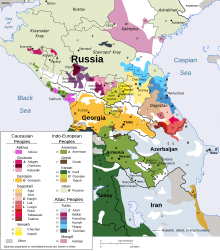
- Source: Fedstat (Суммарный коэффициент рождаемости) Archived 2 April 2022 at the Wayback Machine
| Average population (x 1000) | Live births | Deaths | Natural change | Crude birth rate (per 1000) | Crude death rate (per 1000) | Natural change (per 1000) | Total fertility rate | |
|---|---|---|---|---|---|---|---|---|
| 2003 | 1,117 | 27,774 | 7,194 | 20 580 | 24.9 | 6.4 | 18.4 | |
| 2004 | 1,133 | 28,496 | 6,347 | 22,149 | 25.2 | 5.6 | 19.5 | |
| 2005 | 1,150 | 28,652 | 5,857 | 22,795 | 24.9 | 5.1 | 19.8 | |
| 2006 | 1,167 | 27,989 | 5,889 | 22,100 | 24.0 | 5.0 | 18.9 | |
| 2007 | 1,187 | 32,449 | 5,630 | 26,819 | 27.3 | 4.7 | 22.6 | 3.18 |
| 2008 | 1,210 | 35,897 | 5,447 | 30,450 | 29.7 | 4.5 | 25.2 | 3.44 |
| 2009 | 1,235 | 36,523 | 6,620 | 29,903 | 29.6 | 5.4 | 24.2 | 3.41 |
| 2010 | 1,260 | 37,753 | 7,042 | 30,711 | 30.0 | 5.6 | 24.4 | 3.45 |
| 2011 | 1,289 | 37,335 | 6,810 | 30,525 | 28.9 | 5.3 | 23.6 | 3.36 |
| 2012 | 1,314 | 34,385 | 7,192 | 27,193 | 26.2 | 5.5 | 20.7 | 3.08 |
| 2013 | 1,336 | 32,963 | 6,581 | 26,382 | 24.7 | 4.9 | 19.8 | 2.93 |
| 2014 | 1,358 | 32,949 | 6,864 | 26,085 | 24.3 | 5.1 | 19.2 | 2.91 |
| 2015 | 1,383 | 32,057 | 6,728 | 25,329 | 23.2 | 4.9 | 18.3 | 2.80 |
| 2016 | 1,404 | 29,893 | 6,630 | 23,263 | 21.3 | 4.7 | 16.6 | 2.62 |
| 2017 | 1,425 | 29,890 | 6,586 | 23,304 | 21.0 | 4.6 | 16.4 | 2.73 |
| 2018 | 1,444 | 29,883 | 6,430 | 23,453 | 20.6 | 4.4 | 16.2 | 2.60 |
| 2019 | 1,467 | 28,145 | 6,357 | 21,788 | 19.2 | 4.3 | 14.9 | 2.58 |
| 2020 | 1,488 | 30,111 | 9,188 | 20,923 | 20.2 | 6.2 | 14.0 | 2.57 |
| 2021 | 1,509 | 30,345 | 8,904 | 21,441 | 20.1 | 5.9 | 14.2 | 2.50 |
| 2022 | 30,821 | 7,370 | 23,451 | 20.2 | 4.8 | 15.4 | 2.74 | |
| 2023 | 30,418 | 6,583 | 23,835 | 19.7 | 4.3 | 15.4 | 2.63 |
Ethnic groups
(in the territory of modern Chechnya)[75][unreliable source]
| Ethnic group |
1926 Census | 1939 Census2 | 1959 Census2 | 1970 Census | 1979 Census | 1989 Census | 2002 Census | 2010 Census | 2021 Census1 | |||||||||
|---|---|---|---|---|---|---|---|---|---|---|---|---|---|---|---|---|---|---|
| Number | % | Number | % | Number | % | Number | % | Number | % | Number | % | Number | % | Number | % | Number | % | |
Chechens
|
293,298 | 67.3% | 360,889 | 58.0% | 238,331 | 39.7% | 499,962 | 54.7% | 602,223 | 60.1% | 715,306 | 66.0% | 1,031,647 | 93.5% | 1,206,551 | 95.3% | 1,456,792 | 96.4% |
| Russians | 103,271 | 23.5% | 213,354 | 34.3% | 296,794 | 49.4% | 327,701 | 35.8% | 307,079 | 30.6% | 269,130 | 24.8% | 40,645 | 3.7% | 24,382 | 1.9% | 18,225 | 1.2% |
| Kumyks | 2,217 | 0.5% | 3,575 | 0.6% | 6,865 | 0.8% | 7,808 | 0.8% | 9,591 | 0.9% | 8,883 | 0.8% | 12,221 | 1.0% | 12,184 | 0.8% | ||
Avars
|
830 | 0.2% | 2,906 | 0.5% | 4,196 | 0.5% | 4,793 | 0.5% | 6,035 | 0.6% | 4,133 | 0.4% | 4,864 | 0.4% | 4,079 | 0.3% | ||
| Nogais | 162 | 0.0% | 1,302 | 0.2% | 5,503 | 0.6% | 6,079 | 0.6% | 6,885 | 0.6% | 3,572 | 0.3% | 3,444 | 0.3% | 2,819 | 0.2% | ||
| Ingush | 798 | 0.2% | 4,338 | 0.7% | 3,639 | 0.6% | 14,543 | 1.6% | 20,855 | 2.1% | 25,136 | 2.3% | 2,914 | 0.3% | 1,296 | 0.1% | 1,100 | 0.1% |
| Ukrainians | 11,474 | 2.6% | 8,614 | 1.4% | 11,947 | 2.0% | 11,608 | 1.3% | 11,334 | 1.1% | 11,884 | 1.1% | 829 | 0.1% | 13,716 | 1.1% | 15,625 | 1.0% |
| Armenians | 5,978 | 1.4% | 8,396 | 1.3% | 12,136 | 2.0% | 13,948 | 1.5% | 14,438 | 1.4% | 14,666 | 1.4% | 424 | 0.0% | ||||
| Others | 18,840 | 4.13% | 18,646 | 3.0% | 37,550 | 6.3% | 30,057 | 3.3% | 27,621 | 2.8% | 25,800 | 2.4% | 10,639 | 1.0% | ||||
| 1 2,515 people were registered from administrative databases, and could not declare an ethnicity. It is estimated that the proportion of ethnicities in this group is the same as that of the declared group.[76]
2 Practically all | ||||||||||||||||||
Religion
Islam
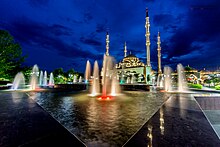
Following the end of the Soviet Union, there has been an
Christianity
From the 11th to 13th centuries (i.e. before
The once-strong Russian minority in Chechnya, mostly
Politics
Since 1990, the Chechen Republic has had many legal, military, and civil conflicts involving separatist movements and pro-Russian authorities. Chechnya has enjoyed a period of relative stability under the Russian-appointed government, although there is still some separatist movement activity.[84] Its regional constitution entered into effect on 2 April 2003, after an all-Chechen referendum was held on 23 March 2003. Some Chechens were controlled by regional teips, or clans, despite the existence of pro- and anti-Russian political structures.
Regional government
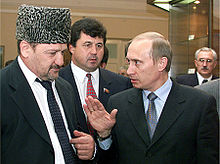
The former separatist religious leader (mufti)
Separatist government
Ichkeria was a member of the
The president of this government was
The successor of Saidullayev became
During the
Human rights
Тhe Internal Displacement Monitoring Center reports that after hundreds of thousands of ethnic Russians and Chechens fled their homes following inter-ethnic and separatist conflicts in Chechnya in 1994 and 1999, more than 150,000 people still remain displaced in Russia today.[93]
Нuman rights groups criticized the conduct of the 2005 parliamentary elections as unfairly influenced by the central Russian government and military.[94]
In 2006, Human Rights Watch reported that pro-Russian Chechen forces under the command of Ramzan Kadyrov, as well as federal police personnel, used torture to get information about separatist forces. "If you are detained in Chechnya, you face a real and immediate risk of torture. And there is little chance that your torturer will be held accountable", said Holly Cartner, Director of the Europe and Central Asia division of the Human Rights Watch.[95]
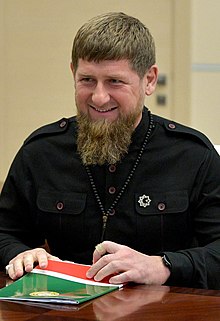
In 2009, the US government financed American organization
On 1 February 2009, The New York Times released extensive evidence to support allegations of consistent torture and executions under the Kadyrov government. The accusations were sparked by the assassination in Austria of a former Chechen rebel who had gained access to Kadyrov's inner circle, 27-year-old Umar Israilov.[98]
On 1 July 2009,
On 10 March 2011, Human Rights Watch reported that since Chechenization, the government has pushed for enforced Islamic dress code.[100] The president Ramzan Kadyrov is quoted as saying "I have the right to criticize my wife. She doesn't [have the right to criticize me]. With us [in Chechen society], a wife is a housewife. A woman should know her place. A woman should give her love to us [men]... She would be [man's] property. And the man is the owner. Here, if a woman does not behave properly, her husband, father, and brother are responsible. According to our tradition, if a woman fools around, her family members kill her... That's how it happens, a brother kills his sister or a husband kills his wife... As a president, I cannot allow for them to kill. So, let women not wear shorts...".[101] He has also openly defended honor killings on several occasions.[102]
On 9 July 2017, Russian newspaper Novaya Gazeta reported that a number of people were extrajudicially executed on the night of 26 January 2017. It published a list of 27 names of the people known to be dead, but stressed that the list is "not all [of those killed]"; the newspaper asserted that 50 people may have been executed. [103] Some of the dead were gay, but not all. The killings appeared to have been precipitated by the death of a policeman;[103] according to the author of the report, Elena Milashina, the victims were executed for engaging in terrorism.[104]
In December 2021, up to 50 family members of critics of the Kadyrov government were abducted in a wave of mass kidnappings beginning on 22 December.[105]
In a case study published in 2021, Freedom House reported that Kadyrov also conducts a total transnational repression campaign against Chechen exiles outside of Russia, including assassinations of critics and digital intimidation.[106]
LGBT rights
Although homosexuality is officially legal in Chechnya per Russian law, it is de facto illegal. Chechen authorities have reportedly arrested, imprisoned and killed persons based on their perceived sexual orientation.[107]
In 2017, it was reported by
On 11 January 2019, it was reported that another "gay purge" had begun in the country in December 2018, with several men and women being detained.[115][116][117][118] The Russian LGBT Network believes that around 40 people were detained and two killed.[119][120]
Economy

During the First Chechen War, the Chechen economy fell apart.[121] In 1994, the separatists planned to introduce a new currency, but the change did not occur due to the re-taking of Chechnya by Russian troops in the Second Chechen War.[121]
The economic situation in Chechnya has improved considerably since 2000. According to the New York Times, major efforts to rebuild Grozny have been made, and improvements in the political situation have led some officials to consider setting up a tourism industry, though there are claims that construction workers are being irregularly paid and that poor people have been displaced.[122]
Chechnya's unemployment was 67% in 2006 and fell to 21.5% in 2014.[123]
Total revenue of the budget of Chechnya for 2017 was 59.2 billion rubles. Of these, 48.5 billion rubles were grants from the federal budget of the Russian Federation.
In late 1970s, Chechnya produced up to 20 million tons of oil annually, production declined sharply to approximately 3 million tons in the late 1980s, and to below 2 million tons before 1994, first (1994–1996) second Russian invasion of Chechnya (1999) inflicted material damage on the oil-sector infrastructure, oil production decreased to 750,000 tons in 2001 only to increase to 2 million tons in 2006, by 2012 production was 1 million tons.[124]
Culture
The culture of Chechnya is based on the native traditions of Chechen people. Chechen mythology along with art have helped shape the culture for over 1,000 years.
From April 2024, all music must have a tempo between 80 and 116 beats per minute, to comply with Chechen traditions. Borrowing musical culture from other peoples is not allowed.[125]
References
- ^ Президент Российской Федерации. Указ №849 от 13 мая 2000 г. «О полномочном представителе Президента Российской Федерации в федеральном округе». Вступил в силу 13 мая 2000 г. Опубликован: "Собрание законодательства РФ", No. 20, ст. 2112, 15 мая 2000 г. (President of the Russian Federation. Decree #849 of May 13, 2000 On the Plenipotentiary Representative of the President of the Russian Federation in a Federal District. Effective as of May 13, 2000.).
- ^ Госстандарт Российской Федерации. №ОК 024-95 27 декабря 1995 г. «Общероссийский классификатор экономических регионов. 2. Экономические районы», в ред. Изменения №5/2001 ОКЭР. (Gosstandart of the Russian Federation. #OK 024-95 December 27, 1995 Russian Classification of Economic Regions. 2. Economic Regions, as amended by the Amendment #5/2001 OKER. ).
- ^ Decree #164
- ^ a b Constitution, Article 5.1
- ^ Official website of the Chechen Republic. Ramzan Akhmatovich Kadyrov Archived 11 August 2011 at the Wayback Machine (in Russian)
- Federal Service for State Registration, Cadastre and Cartography. Archived from the originalon 9 February 2022. Retrieved 29 August 2023.
- ^ a b c "Оценка численности постоянного населения по субъектам Российской Федерации". Federal State Statistics Service. Retrieved 1 September 2022.
- ^ "Об исчислении времени". Официальный интернет-портал правовой информации (in Russian). 3 June 2011. Retrieved 19 January 2019.
- ^ Official throughout the Russian Federation according to Article 68.1 of the Constitution of Russia.
- ^ Constitution of the Chechen Republic, Article 10.1
- ^ Law #4071-1
- ISBN 978-1-135-09584-0.
- ^ "Ramzan Kadyrov: Putin's key Chechen ally". BBC. 21 May 2020. Retrieved 7 March 2022.
- ^ The work of Leonti Mroveli: "The history of the Georgian Kings" dealing with the history of Georgia and the Caucasus since ancient times to the 5th century AD, is included in medieval code of Georgian annals "Kartlis Tskhovreba".
- ^ "An Essay on the History of the Vainakh People. On the origin of the Vainakhs". Caucasian Knot. 14 January 2004. Archived from the original on 10 April 2023. Retrieved 25 May 2023.
- ^ Anchabadze, George (2009) [first edition 2001]. The Vainakhs (the Chechen and Ingush) (PDF). Tbilisi: Caucasian House. Archived from the original (PDF) on 25 February 2012. Retrieved 3 November 2012.
- ^ S2CID 82205296.
- ^ ISBN 978-0-415-32328-4. Retrieved 14 August 2009.
- ^ a b N. D. Kodzoev. History of Ingush nation.
- ^ Sampiyev, Hasan. Страна башен [Tower country]. Ингушетия.Ru. Archived from the original on 17 February 2008. Retrieved 14 March 2014.
- ^ Tesaev, Amin (2020). "К личности и борьбе чеченского героя идига (1238–1250 гг.)".
{{cite journal}}: Cite journal requires|journal=(help) - ^ Krasnov, A. I. Копье Тебулос-Мта. Вокруг света. 9: 29.
- ^ Tesaev, Amin (2018). "Симсим". Рефлексия. 2: 61–67.
- ^ "Предводитель Гази Алдамов, или Алдаман ГIеза (Амин Тесаев) / Проза.ру". proza.ru.
- ISBN 978-2-7068-1792-2.
- ISBN 978-5-904549-02-2. Archived(PDF) from the original on 5 July 2010.
- ^ ISBN 9780313386343. Retrieved 25 December 2014.
- ]
- ^ a b c "The Ingush People". Linguistics.berkeley.edu. 28 November 1992. Retrieved 14 March 2014.
- ^ John Frederick Baddeley, The Russian Conquest of the Caucasus, London, Curzon Press, 1999, p. 49.
- ISBN 9780275964818. Retrieved 25 December 2014.
- ^ "Человек из камня Байсангур Беноевский". 10 December 2010. Archived from the original on 24 November 2021. Retrieved 14 March 2014 – via YouTube.
- ^ "Independent Mountainous Republic of the Northern Caucasus". Countries & Territories since 1900. Archived from the original on 25 May 2023. Retrieved 25 May 2023.
- ^ "Общественное движение чеченский комитет национального спасения". Savechechnya.com. 24 June 2008. Archived from the original on 23 February 2014. Retrieved 14 March 2014.
- ^ "Вассан-Гирей Джабагиев". Vainah.info. Archived from the original on 21 February 2014. Retrieved 14 March 2014.
- ^ Umarova, Amina (23 November 2013). "Chechnya's Forgotten Children of the Holodomor". Radio Free Europe/Radio Liberty. Retrieved 14 March 2014.
- ^ a b c d e f Lieven, Dominic. "Russia: Chechnya". Microsoft Encarta 2008. Microsoft.
- ^ "Remembering Stalin's deportations". BBC News. 23 February 2004. Retrieved 19 April 2013.
- ^ Fires of Hatred: Ethnic Cleansing in Twentieth-Century Europe, Cambridge, Massachusetts and London: Harvard University Press, 2001, pp. 96–97.
- ISBN 5-85646-097-9, pp. 205–206.
- ^ Bugay 1996, p. 106.
- ^ "Chechnya: European Parliament recognizes the genocide of the Chechen People in 1944". Unrepresented Nations and Peoples Organization.
- ^ James Hughes. "The Peace Process in Chechnya", in Richard Sakwa (ed.), Chechnya: From Past to Future, p. 271.
- ^ "'Dual attack' killed president". BBC. 21 April 1999. Retrieved 1 January 2016.
- ^ "Radio Free Europe/Radio Liberty archive". friends-partners.org. Friends & Partners. 12 May 1997. part I. Archived from the original on 17 November 2015. Retrieved 1 January 2016.
- ^ "Chechnya [Russia] (2003)". Freedom House. Archived from the original on 24 October 2011.
- ^ ISBN 978-1-4165-5165-2.
- ^ Tishkov, Valery. Chechnya: Life in a War-Torn Society. Berkeley: University of California Press, 2004, p. 114.
- ^ "Four Western hostages beheaded in Chechnya". CNN. Archived from the original on 3 December 2002.
- ^ Harrigan, Steve. "Moscow again plans wider war in Dagestan". CNN. 19 August 1999. Retrieved 23 April 2013.
- ^ "Context of 'September 13, 1999: Second Moscow Apartment Bombing Kills 118; Chechen Rebels Blamed'". History Commons. Archived 15 February 2013 at the Wayback Machine. Retrieved 23 April 2013.
- ^ "Gay Chechens flee threats, beatings and exorcism". BBC News. 5 April 2018. Retrieved 10 October 2018.
- ^ Andrew Meier (2005). Chechnya: To the Heart of a Conflict. New York: W. W. Norton
- ^ "Gas 'killed Moscow hostages'". BBC News. 27 October 2002. Retrieved 19 April 2013.
- ^ "Moscow court begins siege claims". BBC News. 24 December 2002.
- ^ "Moscow hostage relatives await news". BBC News. 27 October 2002. Retrieved 30 May 2011.
- ^ Aris, Ben (24 March 2003). "Boycott call in Chechen poll ignored". The Daily Telegraph. London. Archived from the original on 10 January 2022. Retrieved 22 April 2013.
- ^ "Putin's proposition". The Economist. 25 March 2003. Retrieved 22 April 2013.
- ^ "August 31, 2006: Beslan – Two Years On". Archived from the original on 4 April 2009. Retrieved 4 April 2009.
- ^ "Putin meets angry Beslan mothers". BBC News. Retrieved 23 April 2013.
- ^ "The children of Beslan five years on". BBC News. Retrieved 23 April 2013.
- ^ "Ramzan Kadyrov: The warrior king of Chechnya". The Independent. 4 January 2007. Retrieved 1 January 2016.
- ^ "Kadyrov's Power and Cult of Personality Grows". Jamestown. Retrieved 1 January 2016.
- ^ "Russia 'ends Chechnya operation'". BBC News. 16 April 2009. Retrieved 14 April 2009.
- ^ "Salafist-Takfiri Jihadism: the Ideology of the Caucasus Emirate". International Institute for Counter-Terrorism. Archived from the original on 3 September 2014. Retrieved 27 August 2019.
- ^ Cranny-Evans, Sam (4 November 2022). "The Chechens: Putin's Loyal Foot Soldiers". Royal United Services Institute for Defence and Security Studies. Retrieved 23 May 2023.
- ^ "Chechen volunteer fighters back up Ukraine's Russian resistance". ABC News. Retrieved 14 August 2023.
- ^ "Russia Travel Advisory". Department of State. United States.
- ^ Climate of Chechnya. Climate-Data.org. Retrieved 19 October 2020.
- Federal State Statistics Service.
- ^ "Национальный состав населения". Federal State Statistics Service. Retrieved 30 December 2022.
- ^ "Демографический ежегодник России" [The Demographic Yearbook of Russia] (in Russian). Federal State Statistics Service of Russia (Rosstat). Retrieved 1 June 2022.
- ^ "Ожидаемая продолжительность жизни при рождении" [Life expectancy at birth]. Unified Interdepartmental Information and Statistical System of Russia (in Russian). Archived from the original on 20 February 2022. Retrieved 1 June 2022.
- ^ "ЕМИСС". Archived from the original on 3 August 2022. Retrieved 5 August 2022.
- ^ "НАСЕЛЕНИЕ ЧЕЧНИ". Ethno-kavkaz.narod.ru. Retrieved 19 April 2013.
- ^ "Перепись-2010: русских становится больше". Perepis-2010.ru. 19 December 2011. Archived from the original on 25 December 2018. Retrieved 19 April 2013.
- ^ ISBN 5-98704-044-2.
- ^ В Чечне наблюдается высокая степень религиозной нетерпимости [High degree of religious intolerance observed in Chechnya]. Caucasus Times. Caucasus Times poll (in Russian). 16 May 2010. Retrieved 10 April 2017.
- ^ McDermott, Roger. "Shafi'i and Hanafi schools of jurisprudence in Chechnya". Jamestown. Jamestown.org. Retrieved 19 April 2013.
- ISBN 9780765629319.
- ^ Mairbek Vatchagaev (8 September 2006). "The Kremlin's War on Islamic Education in the North Caucasus". Archived from the original on 11 October 2007. Chechnya Weekly, Volume 7, Issue 34 (8 September 2006)
- ^ Nazgul A. Mingisheva and Yesbossyn M. Smagulov, "Chechnya" in Mark Juergensmeyer and Wade Clark Roof, Encyclopedia of Global Religion, Volume 1, SAGE, 2012, p. 193.
- ^ Interfax Information Services Group. "Chechnya saw the first mass baptism in its today's history". Retrieved 9 July 2012.
- ^ "Chechnya profile". BBC. 28 August 2023. Retrieved 15 April 2024.
- ^ "UNPO: Chechen Republic of Ichkeria". unpo.org. Retrieved 27 August 2019.
- ^ in 1993, ex –President of Georgia Zviad Gamsakhurdia recognized Chechnya's independence.., Archived 21 August 2013 at the Wayback Machine
- ^ Are Chechens in Afghanistan? Archived 7 August 2009 at the Wayback Machine – By Nabi Abdullaev, 14 December 2001, Moscow Times
- ^ a b Kullberg, Anssi. "The Background of Chechen Independence Movement III: The Secular Movement". The Eurasian politician. 1 October 2003
- ^ Kari Takamaa and Martti Koskenneimi. The Finnish Yearbook of International Law. p147
- ^ Kuzio, Taras. "The Chechen crisis and the 'near abroad'". Central Asian Survey, Volume 14, Issue 4 1995, pages 553–572
- ^ "What is Hidden Behind the Idea of the Caucasian Emirate?" (PDF). Archived (PDF) from the original on 11 May 2011. Retrieved 19 April 2013.
- ^ "Ukraine lawmakers brand Chechnya 'Russian-occupied' in dig at Kremlin". Reuters. 18 October 2022. Retrieved 20 October 2022.
- ^ Government efforts help only some IDPs rebuild their lives, IDMC, 13 August 2007 Archived 21 August 2013 at the Wayback Machine
- ^ Chechnya Holds Parliamentary Vote, Morning Edition, NPR, 28 November 2005.
- ^ Human Rights Watch:Chechnya: Research Shows Widespread and Systematic Use of Torture
- PDF), Freedom House, March 2009
- ^ Cherkasov, Alexander; Golubev, Ostav; Malykhin, Vladimir (24 February 2023), "A chain of wars, a chain of crimes, a chain of impunity: Russian wars in Chechnya, Syria and Ukraine" (PDF), Memorial Human Rights Defence Centre, p. 9
- ^ Chivers, C. J. (31 January 2009). "Slain Exile Detailed Cruelty of the Ruler of Chechnya". The New York Times.
- ^ Amnesty International:Russian Federation Rule Without Law: Human Rights violations in the North Caucasus Archived 3 February 2019 at the Wayback Machine, 1 July 2009.
- ^ Human Rights Watch:"You Dress According to Their Rules" Enforcement of an Islamic Dress Code for Women in Chechnya Archived 2 April 2015 at the Wayback Machine, 10 March 2011
- ^ правды», Александр ГАМОВ | Сайт «Комсомольской (24 September 2008). "Рамзан КАДЫРОВ: "Россия – это матушка родная"". Kp.ru - (in Russian). Retrieved 27 August 2019.
- ^ Chechen President Kadyrov Defends Honor Killings Archived 5 June 2011 at the Wayback Machine The St. Petersburg Times 3 March 2009
- ^ a b Milashina, Elena (9 July 2017). "Это была казнь. В ночь на 26 января в Грозном расстреляли десятки людей". Novaya Gazeta. Moscow. Retrieved 10 July 2017.
- ^ "Who Is Afraid of Navalny, Killings in Chechnya, Trump-Putin Meeting". Institute of Modern Russia. 14 July 2017. Archived from the original on 21 August 2017. Retrieved 17 July 2017.
- ^ "Dozens of relatives of government critics reportedly kidnapped in Chechnya". OC Media. 28 December 2021. Retrieved 29 December 2021.
- ^ "Russia Case Study | Understanding Transnational Repression". Freedom House. Archived from the original on 21 October 2021. Retrieved 20 February 2024.
- ^ Kramer, Andrew E. (1 April 2017). "Chechen Authorities Arresting and Killing Gay Men, Russian Paper Says". The New York Times. Archived from the original on 28 April 2019. Retrieved 15 April 2017.
- ^ "Chechnya police arrest 100 suspected gay men, three killed: report". The Globe and Mail. Associated Press. 3 April 2017. Retrieved 10 April 2017.
- ^ Duffy, Nick (10 April 2017). "Chechnya has opened concentration camps for gay men". PinkNews. Retrieved 10 April 2017.
- ^ Armstrong, Kathy (10 April 2017). "Over 100 people allegedly sent to 'concentration camps' for gay men in Chechnya". Irish Independent. Retrieved 11 April 2017.
- ^ Gordienko, Irina; Elena Milashina (4 April 2017). Расправы над чеченскими геями [Massacres of Chechen gays (18+)]. Novaya Gazeta (in Russian). Retrieved 12 April 2017.
- ^ a b "Persecution of LGBTI people in the Chechen Republic (Russian Federation), Resolution 2230 (2018)". Parliamentary Assembly of the Council of Europe. 27 June 2018. Retrieved 26 September 2021.
- ^ Walker, Shaun (13 April 2017). "Chechens tell of prison beatings and electric shocks in anti-gay purge: 'They called us animals'". The Guardian. Retrieved 26 September 2021.
- ^ ben Chikha, Foura (21 September 2021). "Combating rising hate against LGBTI people in Europe" (PDF). Council of Europe Committee on Equality and Non-Discrimination. pp. 15–16. Archived (PDF) from the original on 23 September 2021. Retrieved 26 September 2021.
- ^ Vasilyeva, Nataliya (11 January 2019). "Reports: several gay men and women detained in Chechnya". Associated Press. Retrieved 14 January 2019.
- ^ Damshenas, Sam (11 January 2019). "Chechnya has reportedly launched a new 'gay purge'". Gay Times. Retrieved 13 January 2019.
- ^ Carroll, Oliver (11 January 2019). "Chechnya launches new gay 'purge', reports say". The Independent. Retrieved 14 January 2019.
- ^ «Новой газете» стало известно о новых преследованиях геев в Чечне [Novaya Gazeta learned of new persecution of gays in Chechnya]. Novaya Gazeta (in Russian). 11 January 2019. Archived from the original on 11 October 2019. Retrieved 14 January 2019.
- ^ "New wave of persecution against LGBT people in Chechnya: around 40 people detained, at least two killed". Российская ЛГБТ-сеть (in Russian). 14 January 2019. Archived from the original on 30 June 2019. Retrieved 27 August 2019.
- ^ Ingber, Sasha (14 January 2019). "Activists Say 40 Detained And 2 Dead in Gay Purge in Chechnya". NPR. Retrieved 27 August 2019.
- ^ S2CID 153481090.
- ^ Kramer, Andrew E. (30 April 2008). "Chechnya's Capital Rises From the Ashes, Atop Hidden Horrors". The New York Times. Retrieved 1 April 2010.
- ^ "Chechnya, Republic of Unemployment rate, 1990-2014 - knoema.com". Archived from the original on 12 April 2017. Retrieved 11 April 2017.
- ^ "Does Chechnya Stand To Lose Out From Russian-Azerbaijani Oil Agreement?". Radio Free Europe/Radio Liberty. 30 August 2013.
- ^ "Chechnya Forbids Music Outside 80-116 BPM Tempo", Moscow Times, April 5 2024
Notes
- ^ /ˈtʃɛtʃniə/ CHETCH-nee-ə; Russian: Чечня́, IPA: [tɕɪtɕˈnʲa]; Chechen: Нохчийчоь, romanized: Noxçiyçö
- ^ Russian: Чече́нская Респу́блика, romanized: Chechenskaya Respublika; Chechen: Нохчийн Республика, romanized: Noxçiyn Respublika
Sources
- ISBN 9781560723714.
- Президент Чеченской Республики. Указ №164 от 15 июля 2004 г. «О государственном гимне Чеченской Республики». Вступил в силу после одобрения Государственным Советом Чеченской Республики и официального опубликования. Опубликован: БД "Консультант-Плюс". (President of the Chechen Republic. Decree #164 of 15 July 2004 On the State Anthem of the Chechen Republic. Effective as of after the ratification by the State Council of the Chechen Republic and subsequent official publication.).
- Референдум. 23 марта 2003 г. «Конституция Чеченской Республики», в ред. Конституционного закона №1-РКЗ от 30 сентября 2014 г. «О внесении изменений в Конституцию Чеченской Республики». Вступил в силу со дня официального опубликования по результатам голосования на референдуме Чеченской Республики. (Referendum. March 23, 2003 Constitution of the Chechen Republic, as amended by the Constitutional Law #1-RKZ of September 30, 2014 On Amending the Constitution of the Chechen Republic. Effective as of the day of the official publication in accordance with the results of the referendum of the Chechen Republic.).
- President of the Russian Federation. Law #4071-1 of 10 December 1992 On Amending Article 71 of the Constitution (Basic Law) of the Russian Federation–Russia. Effective as of 10 January 1993..
Further reading
- Anderson, Scott. The Man Who Tried to Save the World. ISBN 0-385-48666-9
- ISBN 978-1-84627-039-0
- Baiev, Khassan. The Oath: A Surgeon Under Fire. ISBN 0-8027-1404-8
- ISBN 1-85065-069-1
- Bird, Chris. To Catch a Tartar: Notes from the Caucasus. ISBN 0-7195-6506-5
- Bornstein, Yvonne and Ribowsky, Mark. "Eleven Days of Hell: My True Story of Kidnapping, Terror, Torture And Historic FBI & KGB Rescue" AuthorHouse, 2004. ISBN 1-4184-9302-3.
- Conrad, Roy. Roy Conrad. Grozny. A few days...
- Dunlop, John B. Russia Confronts Chechnya: Roots of a Separatist Conflict ISBN 0-521-63619-1
- Evangelista, Mathew. The Chechen Wars: Will Russia Go the Way of the Soviet Union?. ISBN 0-8157-2499-3.
- Gall, Charlotta & de Waal, Thomas. Chechnya: A Small Victorious War. ISBN 0-330-35075-7
- Gall, Carlotta, and de Waal, Thomas Chechnya: Calamity in the Caucasus ISBN 0-8147-3132-5
- ISBN 0-312-268-74-2
- Hasanov, Zaur. The Man of the Mountains. ISBN 099304445X(facts based novel on growing influence of the radical Islam during 1st and 2nd Chechnya wars)
- Khan, Ali. The Chechen Terror: The Play within the Play
- ISBN 5-89935-057-1.
- ISBN 0-300-07881-1
- Mironov, Vyacheslav. Ya byl na etoy voyne. (I was in this war) Biblion – Russkaya Kniga, 2001. Partial translation available online[dead link].
- Mironov, Vyacheslav. Vyacheslav Mironov. Assault on Grozny Downtown
- Mironov, Vyacheslav. Vyacheslav Mironov. I was in that war.
- Oliker, Olga Russia's Chechen Wars 1994–2000: Lessons from Urban Combat. ISBN 0-8330-2998-3. (A strategic and tactical analysis of the Chechen Wars.)
- Pelton, Robert Young. Hunter Hammer and Heaven, Journeys to Three World's Gone Mad (ISBN 1-58574-416-6)
- ISBN 0-226-67432-0
- Rasizade, Alec. Chechnya: the Achilles heel of Russia. = Contemporary Review (Oxford) in three parts: 1) April 2005 issue, volume 286, number 1671, pages 193–197; 2) May 2005 issue, volume 286, number 1672, pages 277–284; 3) June 2005 issue, volume 286, number 1673, pages 327–332.
- Seirstad, Asne. The Angel of Grozny. ISBN 978-1-84408-395-4
- Wood, Tony. Chechnya: The Case For Independence Book review in The Independent, 2007
External links
- Official website of the Republic of Chechnya (in Russian)
- Chechnya at Curlie
- AlertNet Chechnya and the North Caucasus at the Wayback Machine (archived 11 September 2012)
- "Chechnya's Hidden War". Public Broadcasting Service. 22 March 2010. (video)
- Islamist Extremism in Chechnya: A Threat to U.S. Homeland?: Joint Hearing before the Subcommittee on Europe, Eurasia, and Emerging Threats and the Subcommittee on Terrorism, Nonproliferation, and Trade of the Committee on Foreign Affairs, House of Representatives, One Hundred Thirteenth Congress, First Session, April 26, 2013
- (in English) Chechnya Guide Archived 20 May 2021 at the Wayback Machine




